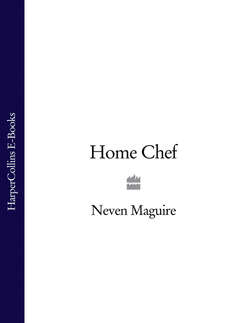Читать книгу Home Chef - Neven Maguire - Страница 55
Glossary
ОглавлениеHave you ever come across a cooking instruction that you’re not sure about? There are so many terms and techniques in cooking, and not all recipes explain them in detail. But don’t be put off cooking a dish because the recipe uses specialist language – in this glossary I’ve explained some of the most important words and phrases that you’ll need to know.
Al Dente The texture of properly cooked pasta, vegetables and risottos. Literally ‘to the tooth’ (in Italian), it describes the slight resistance in the food when bitten.
Baste To spoon or brush a liquid (such as dripping from the pan, butter, fats or a marinade) over foods during roasting or grilling, to keep moist.
Blanch To parboil by immersing in rapidly boiling water for a few seconds or minutes. Normally used for vegetables such as French beans, sugar snap peas and mangetout. This helps to retain colour and flavour.
Braise A slow cooking method used for cuts of meat that are too tough to roast. It is also good for some vegetables. A pan or casserole with a tight-fitting lid should be used so that very little liquid is lost through evaporation. The meat is first browned, then cooked on a bed of roughly chopped vegetables (often called a ‘mirepoix’), with just enough liquid to cover the vegetables. It can be cooked in the oven or on the hob.
Caramelise To heat (under a grill, in a pan or using a chef’s blowtorch) so that the natural sugars in the food burn slightly and go brown. Sugar can also be sprinkled on food to create this effect, as in crème brulée.
Coulis Fruit that is sweetened with sugar and thinned with water, then puréed to form a fruit sauce or decoration for desserts.
Court-bouillon Flavoured liquid used for poaching fish. Made from water and wine or wine vinegar, with herbs and vegetables for flavouring.
Dauphinoise To cook ‘à la Dauphinoise’ means to bake in a slow oven with cream and garlic. A gratin dauphinoise is a classic dish of thinly sliced potatoes cooked with garlic, cream, milk, butter and often Gruyère cheese – rich, but delicious! Serve alongside meat or vegetable dishes.
Deglaze To loosen the sediment from the bottom of a pan by heating a little stock, wine or other liquid, along with cooking juices left in the pan after roasting or sautéing meat, and stirring with a wooden spoon.
Dice To cut into very small cubes of similar size and shape.
Dredge To coat food with flour or another powdered ingredient.
Flambé To flavour a dish with alcohol, usually brandy or rum, which is then ignited so that the actual alcohol content is burnt off, leaving the flavour behind. This can be done with a lighter, although chefs tend to simply tilt the pan and use the flame of the gas! Take great care!!
Fold To gently blend two mixtures, releasing as little air as possible. Cut through the mixture with a spatula or whisk, from bottom to top, rotating the bowl constantly, until thoroughly mixed.
Fondant A classic, restaurant method of cooking potato, producing a deliciously rich and buttery potato dish. Also a baked dessert which is cake-like on the outside but soft in the centre.
Gelatine An unflavoured substance that gives body to mousses and desserts, and aids setting. Available in leaves or powdered form. Traditional forms are not suitable for vegetarians, though some versions now are. A good alternative is agar agar, which is now more widely available from good health food shops. Simply follow the instructions on the packet.
Hull To remove the tough part of fruit under the stalk (e.g. strawberries).
Marinade / To Marinate A marinade is an acidic-based liquid mixture combining various seasonings, used to flavour and tenderise (particularly meat). To marinate meat, either brush food with the mixture or immerse in it and leave for at least 1-3 hours but preferably overnight.
Poach To cook very gently in liquid kept just below boiling point.
Purée To mash until perfectly smooth, either by hand, by pushing through a sieve or by mixing in a food processor or liquidiser.
Reduce To simmer liquid without a lid until much of the moisture evaporates and the sauce has thickened.
Refresh To dip into cold water or run cold water over food that has been parboiled or ‘blanched’ in hot water. This stops food from cooking any further and keeps a good colour.
Rind Thin outer coloured layer of a citrus fruit’s skin. Can be removed with a special zester, a vegetable peeler or a box grater. Also the outer skin on bacon or cheese, which is normally removed.
Sauté To cook gently in a small amount of oil and butter in a pan over a low heat. The butter gives the flavour and the oil prevents it from burning. Also used to give the food a nice golden brown colour.
Seal To brown food very quickly on all sides to seal in juices and flavour, and to improve appearance and colour.
Seasoning A mixture of three parts salt to one part ground black pepper.
Simmer To keep a liquid or sauce at a point just below boiling, so that small bubbles rise slowly to the surface, breaking before they reach it.
Sweat To cook slowly in oil, butter or a mixture of both.
Syrup Sugar dissolved in liquid (usually water) over a medium heat.
Wilt To cook until limp, especially soft leaf vegetables such as spinach, rocket and pak choi.
